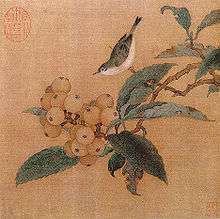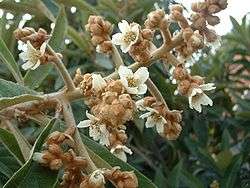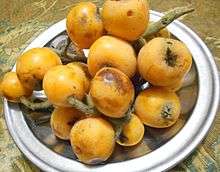Loquat
| Loquat | |
|---|---|
 | |
| Loquat leaves and fruits | |
| Scientific classification | |
| Kingdom: | Plantae |
| (unranked): | Angiosperms |
| (unranked): | Eudicots |
| (unranked): | Rosids |
| Order: | Rosales |
| Family: | Rosaceae |
| Genus: | Eriobotrya |
| Species: | E. japonica |
| Binomial name | |
| Eriobotrya japonica (Thunb.) Lindl. | |
| Synonyms[1] | |
| |
The loquat (Eriobotrya japonica) (from Cantonese Chinese: 盧橘; Jyutping: lou4gwat1, nowadays called Chinese: 枇杷; pinyin: pípá; Jyutping: pei4paa4) is a species of flowering plant in the family Rosaceae, a native to the cooler hill regions of China to south-central China.[2][3] It is also quite common in Japan, Korea, hilly Regions of India (Himachal), Northern Areas of Pakistan and some can be found in some Northern part of the Philippines, and hill country in Sri Lanka.
It is a large evergreen shrub or tree, grown commercially for its yellow fruit, and also cultivated as an ornamental plant. It is a common ornamental in Adelaide, South Australia.
Eriobotrya japonica was formerly thought to be closely related to the genus Mespilus, and is still sometimes known as the Japanese medlar. It is also known as Japanese plum[4] and Chinese plum,[5] also known as pipa in China.
Description
Eriobotrya japonica is a large evergreen shrub or small tree, with a rounded crown, short trunk and woolly new twigs. The tree can grow to 5–10 metres (16–33 ft) tall, but is often smaller, about 3–4 metres (10–13 ft). The fruit begins to ripen during Spring to Summer depending on the temperature on the area. The leaves are alternate, simple, 10–25 centimetres (4–10 in) long, dark green, tough and leathery in texture, with a serrated margin, and densely velvety-hairy below with thick yellow-brown pubescence; the young leaves are also densely pubescent above, but this soon rubs off.[6][7][8][9]
Fruit

Loquats are unusual among fruit trees in that the flowers appear in the autumn or early winter, and the fruits are ripe at any time from early spring to early summer.[10] The flowers are 2 cm (1 in) in diameter, white, with five petals, and produced in stiff panicles of three to ten flowers. The flowers have a sweet, heady aroma that can be smelled from a distance.
Loquat fruits, growing in clusters, are oval, rounded or pear-shaped, 3–5 centimetres (1–2 in) long, with a smooth or downy, yellow or orange, sometimes red-blushed skin. The succulent, tangy flesh is white, yellow or orange and sweet to subacid or acid, depending on the cultivar.
Each fruit contains from one to ten ovules, with three to five being most common.[11] A variable number of the ovules mature into large brown seeds (with different numbers of seeds appearing in each fruit on the same tree, usually between one and four). The skin, though thin, can be peeled off manually if the fruit is ripe. In Egypt, varieties with sweeter fruits and fewer seeds are often grafted on inferior quality specimens.
The fruits are the sweetest when soft and orange. The flavour is a mixture of peach, citrus and mild mango.
History

The loquat is originally from China (the Chinese name is pipa, cognate with the pipa instrument) where related species can be found growing in the wild.[12][13][14][15] It was introduced into Japan and became naturalised there in very early times;[16] it has been cultivated there for over 1,000 years. It has also become naturalised in Georgia, Armenia, Afghanistan, Australia, Azerbaijan, Bermuda, Chile, Kenya, India, Iran, Iraq, South Africa, the whole Mediterranean Basin, Pakistan, New Zealand, Réunion, Tonga, Central America, Mexico, South America and in warmer parts of the United States (Hawaii, California, Texas, Louisiana, Alabama, Florida, Georgia, and South Carolina). Chinese immigrants are presumed to have carried the loquat to Hawaii.[17][18] It has been cultivated in Japan for about 1,000 years and presumably the fruits and seeds were brought back from China to Japan by the many Japanese scholars visiting and studying in China during the Tang Dynasty.
The loquat was often mentioned in ancient Chinese literature, such as the poems of Li Bai.
Cultivation
Over 800 loquat cultivars exist in Asia. Self-fertile variants include the 'Gold Nugget' and 'Mogi' cultivars.[19] The loquat is easy to grow in subtropical to mild temperate climates where it is often primarily grown as an ornamental plant, especially for its sweet-scented flowers, and secondarily for its delicious fruit. The boldly textured foliage adds a tropical look to gardens, contrasting well with many other plants. It is popular in the American South.


There are many named cultivars, with orange or white flesh.[20] Some cultivars are intended for home-growing, where the flowers open gradually, and thus the fruit also ripens gradually, compared to the commercially grown species where the flowers open almost simultaneously, and the whole tree's fruit also ripens together.
Japan is the leading producer of loquats followed by Israel and then Brazil.[20] In Europe, Spain is the main producer of loquat.[21]
In temperate climates it is grown as an ornamental with winter protection, as the fruits seldom ripen to an edible state. In the United Kingdom, it has gained the Royal Horticultural Society's Award of Garden Merit.[22]
In the highland parts of Central America, the loquat has become naturalized, and is often found growing wild in areas that have been disturbed but abandoned, its seeds having been dispersed by birds. Below 1000 meters, the fruit remains inedible for its high acidity, but above it, the wild fruit is appreciated and much harvested for its sweet, fruity flavor. It is occasionally planted for living fenceposts, as the tree is long-lived, not much subject to disease, and the wood is hard and durable. Good quality logs are much sought-after by furniture makers in Central America, who prize its hardness and durability .
In the US, the loquat tree is hardy only in USDA zones 8 and above, and will flower only where winter temperatures do not fall below 30 °F (−1 °C). In such areas, the tree flowers in autumn and the fruit ripens in late winter.[19]
Culinary use

The loquat has a high sugar, acid, and pectin content.[23] It is eaten as a fresh fruit and mixes well with other fruits in fresh fruit salads or fruit cups. The fruits are also commonly used to make jam, jelly, and chutney, and are often served poached in light syrup. Firm, slightly immature fruits are best for making pies or tarts.
The fruit is sometimes canned. The waste ratio, however, is 30 percent or more, due to the seed size.
The fruit is also processed into confections.
Alcoholic beverages
Loquats can also be used to make light wine. It is fermented into a fruit wine, sometimes using just the crystal sugar and white liquor.
In Italy nespolino[24] liqueur is made from the seeds, reminiscent of nocino and amaretto, both prepared from nuts and apricot kernels. Both the loquat seeds and the apricot kernels contain cyanogenic glycosides, but the drinks are prepared from varieties that contain only small quantities (such as Mogi and Tanaka[25]), so there is no risk of cyanide poisoning.
Nutrition
| Nutritional value per 100 g (3.5 oz) | |
|---|---|
| Energy | 197 kJ (47 kcal) |
|
12.14 g | |
| Dietary fiber | 1.7 g |
|
0.2 g | |
|
0.43 g | |
| Vitamins | |
| Vitamin A equiv. |
(10%) 76 μg |
| Thiamine (B1) |
(2%) 0.019 mg |
| Riboflavin (B2) |
(2%) 0.024 mg |
| Niacin (B3) |
(1%) 0.18 mg |
| Vitamin B6 |
(8%) 0.1 mg |
| Folate (B9) |
(4%) 14 μg |
| Vitamin C |
(1%) 1 mg |
| Minerals | |
| Calcium |
(2%) 16 mg |
| Iron |
(2%) 0.28 mg |
| Magnesium |
(4%) 13 mg |
| Manganese |
(7%) 0.148 mg |
| Phosphorus |
(4%) 27 mg |
| Potassium |
(6%) 266 mg |
| Sodium |
(0%) 1 mg |
| Zinc |
(1%) 0.05 mg |
|
| |
| |
|
Percentages are roughly approximated using US recommendations for adults. Source: USDA Nutrient Database | |
The loquat is low in saturated fat and sodium, and is high in vitamin A, dietary fiber, potassium, and manganese.[26]
Like most related plants, the seeds (pips) and young leaves of the plant are slightly poisonous, containing small amounts of cyanogenic glycosides (including amygdalin) which release cyanide when digested, though the low concentration and bitter flavour normally prevent enough being eaten to cause harm.
Medicinal
Loquat syrup is used in Chinese medicine for soothing the throat and is a popular ingredient for cough drops. The leaves, combined with other ingredients and known as pipa gao (枇杷膏; pinyin: pípágāo; literally "loquat paste"), it acts as a demulcent and an expectorant, as well as to soothe the digestive and respiratory systems.
In Japan, loquat leaves are dried to make a mild beverage known as biwa cha by brewing them using the traditional Japanese method. Biwa cha is held to beautify skin and heal inflammatory skin conditions such as psoriasis and eczema and to heal chronic respiratory conditions such as bronchitis. Eaten in quantity, loquats have a gentle but noticeable sedative effect, lasting up to 24 hours.[27]
Etymology
The name loquat derives from lou4 gwat1, the Cantonese pronunciation of the classical Chinese: 蘆橘; pinyin: lújú, literally "black orange". The phrase "black orange" originally actually referred to unripened kumquats, which are dark green in color. But the name was mistaken as the loquat we know today by the ancient Chinese poet Su Shi when he was residing in southern China, and the mistake was widely taken up by the Cantonese region thereafter.
In Armenian it is called "Nor Ashkhar" (նոր աշխարհ) which means New World because it ushers in Spring.
In Arabic, it's called (Askadenya) إسكدنيا.
In Hebrew, it is called "Sheseq" שסק.
See also
- Kumquat (Although kumquats are not related botanically to loquats, the two names share an origin in their old Chinese names.)
- Coppertone loquat, a hybrid of Eriobotrya deflexa (synonym: Photinia deflexa) and Rhaphiolepis indica
References
Citations
- ↑ "The Plant List: A Working List of All Plant Species". Retrieved 13 April 2014.
- ↑ "Loquat Fact Sheet". UC Davis College of Agricultural & Environmental Sciences.
- ↑ "Flora of China".
- ↑ "Japanese Plum / Loquat". University of Florida, Nassau County Extension, Horticulture. Retrieved 20 March 2012.
- ↑ Linda M. Hunt; Nedal Hamdi Arar & Laurie L. Akana (2000). "Herbs, Prayer, and Insulin Use of Medical and Alternative Treatments by a Group of Mexican American Diabetes Patients". The Journal of Family Practice. 49 (3).
- ↑ Lindley, John. 1821. Transactions of the Linnean Society of London 13(1): 102, Eriobotrya japonica
- ↑ Thunberg, Carl Peter. 1780. Nova Acta Regiae Societatis Scientiarum Upsaliensis 3: 208, Mespilus japonica
- ↑ Ascherson, Paul Friedrich August & Schweinfurth, Georg August. 1887. Illustration de la Flore d'Égypte 73, Photinia japonica
- ↑ Davidse, G., M. Sousa Sánchez, S. Knapp & F. Chiang Cabrera. 2014. Saururaceae a Zygophyllaceae. 2(3): ined. In G. Davidse, M. Sousa Sánchez, S. Knapp & F. Chiang Cabrera (eds.) Flora Mesoamericana. Universidad Nacional Autónoma de México, México D.F..
- ↑ "LOQUAT Fruit Facts". California Rare Fruit Growers, Inc. Retrieved 1 April 2017.
- ↑ "Loquat". Hort.purdue.edu. Retrieved 8 May 2013.
- ↑ "Loquat, production and market." (PDF). First international symposium on loquat. Zaragoza : CIHEAM Options Méditerranéennes.
- ↑ Lin, S., Sharpe, R. H., and Janick, J. (1999). "Loquat: Botany and Horticulture." (PDF). Horticultural Reviews. 23: 235–236.
- ↑ Li, G. F., Zhang, Z. K., and Lin, S. Q. "Origin and Evolution of Eriobotrya.". ISHS Acta Horticulturae 887: III International Symposium on Loquat.
- ↑ Zhang, H. Z., Peng, S. A., Cai, L. H., and Fang, D. Q. (1990). "The germplasm resources of the genus Eriobotrya with special reference on the origin of E. japonica Lindl.". 17 (1 ed.). Acta Horticulturae Sinica: 5–12.
- ↑ Soriano, J. M., Romero, C., Villanova, S., Llacer, G., and Badenes, M. L. (2005). "Genetic diversity of loquat germplasm (Eriobotrya japonica (Thunb) Lindl) assessed by SSR markers.". Genome. 48: 108–114. doi:10.1139/g04-101.
- ↑ Biota of North America Project, Eriobotrya japonica
- ↑ Weeds of Australia, Queensland Biosecurity Edition, loquat, Eriobotrya japonica
- 1 2 Staub 2008, p. 133.
- 1 2 Description from California Rare Fruit Growers, Inc.
- ↑ http://canales.hoy.es/canalagro/datos/frutas/frutas_tradicionales/nisperos.htm
- ↑ "RHS Plant Selector Eriobotrya japonica (F) AGM / RHS Gardening". Apps.rhs.org.uk. Retrieved 8 May 2013.
- ↑ California Rare Fruit Growers (1997). "Loquat". Retrieved 14 October 2014.
- ↑ "World News - Eriobotrya_japonica". Cosplaxy.com. Retrieved 8 May 2013.
- ↑ Tropical and Subtropical Fruits: Postharvest Physiology, Processing and Packaging. Editor(s): Muhammad Siddiq
- ↑ Wolfram Alpha entry
- ↑ pfaf.org database
Works cited
- Botanical and Horticultural Information on the Loquat (Traditional Chinese).
- Staub, Jack (2008). 75 Remarkable Fruits For Your Garden. Gibbs Smith. ISBN 978-1-4236-0881-3.
External links
| Look up loquat in Wiktionary, the free dictionary. |
| Wikimedia Commons has media related to Loquat — Eriobotrya japonica. |
- Loquat Fruit Facts from the California Rare Fruit Growers
- Purdue University Center for New Crops & Plant Products Loquat webpage
- Loquat Growing in the Florida Home Landscape, from the University of Florida IFAS Extension Website